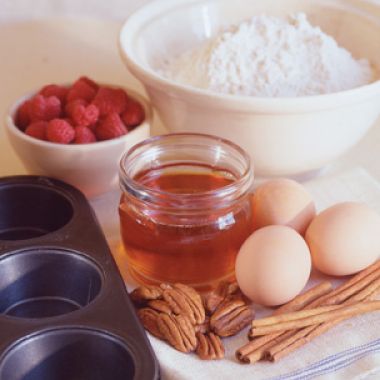
Muffins and quick breads can be savory or sweet; coffee cakes, crowned with a topping, usually star at the breakfast table. They're simple to prepare because they rely on chemical leaveners, rather than yeast.
Understanding Leaveners
To lighten their batters, muffins, coffee cakes and quick breads use a chemical leavener, such as baking powder or baking soda, and sometimes both, plus the actions of creaming and beating in air.
Baking soda, also known as bicarbonate of soda, is used when a batter includes buttermilk, yogurt, sour cream, molasses, honey, maple syrup, citrus, or other fresh fruit or fruit juice. Upon contact with these acidic ingredients, baking soda fosters a simple chemical reaction that produces carbon dioxide gas.
The carbon dioxide bubbles expand when they come in contact with liquid and continue to expand in the heat of the oven. During baking, the trapped bubbles create steam, which releases into the batter and makes a nicely rounded, moist bread. A batter using baking soda must be baked shortly after mixing for best results. If it sits long after mixing, it will lose volume.
Baking powder contains both alkaline and acid components. Because it is complete within itself, the batter in which it is used does not have to include an acidic liquid such as buttermilk. Most powders are "double acting," meaning that they react twice: by producing carbon dioxide bubbles in the batter when the dry ingredients are moistened with liquid and again in the heat of the oven.
Batters made with baking powder improve slightly in texture and flavor if allowed to rise at room temperature for 15 to 20 minutes. They may also sit in the refrigerator for up to 24 hours before baking. Some heavy batters include both types of leaveners, which help them bake into light-textured breads.
Store both types of leaveners in a cool, dry place. They can lose potency over time and should be replaced after 4 to 6 months.
Baking and Cooling
Muffins are done when golden brown around the edges and springy to the touch on top. Most quick breads will have browned tops, and the loaves will be firm, begin to pull away from the pan sides, and have a characteristic crack down the center. Coffee cakes are generally done when the top or topping is golden brown. To check the interior for doneness, insert a toothpick into the center of a muffin or loaf—it should come out clean.
Most muffins and quick breads should be cooled in their pans on a wire rack for 5 minutes or more; this allows the heat to dissipate and helps set the tender texture. Then they are turned out of the pans and placed on the rack to continue cooling. If allowed to cool completely in their pans, the breads can be difficult to unmold, and the bottoms can easily turn soggy.
Understanding Leaveners
To lighten their batters, muffins, coffee cakes and quick breads use a chemical leavener, such as baking powder or baking soda, and sometimes both, plus the actions of creaming and beating in air.
Baking soda, also known as bicarbonate of soda, is used when a batter includes buttermilk, yogurt, sour cream, molasses, honey, maple syrup, citrus, or other fresh fruit or fruit juice. Upon contact with these acidic ingredients, baking soda fosters a simple chemical reaction that produces carbon dioxide gas.
The carbon dioxide bubbles expand when they come in contact with liquid and continue to expand in the heat of the oven. During baking, the trapped bubbles create steam, which releases into the batter and makes a nicely rounded, moist bread. A batter using baking soda must be baked shortly after mixing for best results. If it sits long after mixing, it will lose volume.
Baking powder contains both alkaline and acid components. Because it is complete within itself, the batter in which it is used does not have to include an acidic liquid such as buttermilk. Most powders are "double acting," meaning that they react twice: by producing carbon dioxide bubbles in the batter when the dry ingredients are moistened with liquid and again in the heat of the oven.
Batters made with baking powder improve slightly in texture and flavor if allowed to rise at room temperature for 15 to 20 minutes. They may also sit in the refrigerator for up to 24 hours before baking. Some heavy batters include both types of leaveners, which help them bake into light-textured breads.
Store both types of leaveners in a cool, dry place. They can lose potency over time and should be replaced after 4 to 6 months.
Baking and Cooling
Muffins are done when golden brown around the edges and springy to the touch on top. Most quick breads will have browned tops, and the loaves will be firm, begin to pull away from the pan sides, and have a characteristic crack down the center. Coffee cakes are generally done when the top or topping is golden brown. To check the interior for doneness, insert a toothpick into the center of a muffin or loaf—it should come out clean.
Most muffins and quick breads should be cooled in their pans on a wire rack for 5 minutes or more; this allows the heat to dissipate and helps set the tender texture. Then they are turned out of the pans and placed on the rack to continue cooling. If allowed to cool completely in their pans, the breads can be difficult to unmold, and the bottoms can easily turn soggy.
Adapted from
Williams-Sonoma Collection Series,
Muffins,
by Beth Hensperger
(Simon & Schuster, 2003).











